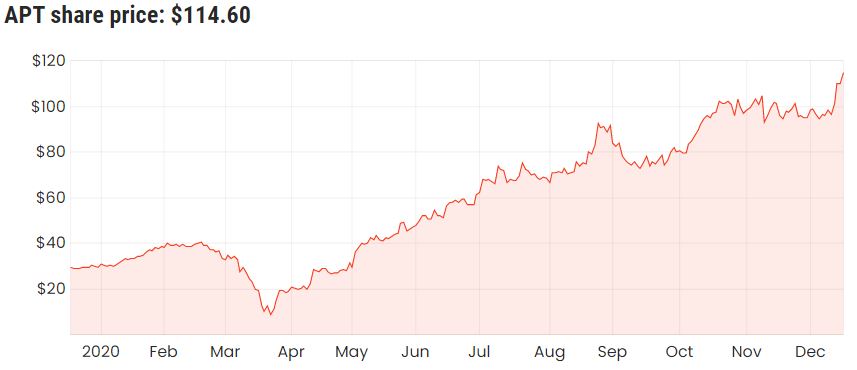There were lots of smart fund managers who said from the beginning that shares in Afterpay Ltd (ASX: APT) weren’t close to being worthy of a position in their ASX share portfolios.
After every month that went by the valuation kept rising, but many funds maintained the same negative sentiment towards Afterpay shares. Whether the fundies were wrong, or if Afterpay has somehow defied all odds, I can’t tell you for sure.
That being said, the recent rally may have left some investors wondering if it’s too late to join, or if the buy-now-pay-later (BNPL) phase will ease off at some point.

Why is the Afterpay share price surging?
Investors again started gaining interest in Afterpay after it was announced earlier this week that APT shares would be joining the S&P/ASX20 index (ASX: XTL). This change will be effective prior to December 21. Insurance Australia Limited (ASX: IAG) is set to be removed.
I can’t help but wonder if the recent gain is mainly the result of retail investors hoping to make a quick profit in the lead up to the inclusion, or if it’s actually index funds buying shares which have helped the APT share price. If I had to guess, it would probably be the former. And I can see why: investors who bought into Afterpay shares have been rewarded with a 15% gain in roughly a week.
Are shares a buy today?
If you’re more of a long-term investor than a trader, it may be worth considering if you think that being included in the ASX 20 index will provide a long-term, sustainable tailwind that can help Afterpay’s business perform better in the long-run, or if this is just a once-off thing.
Keep in mind the ASX 20 is comprised of the largest 20 ASX-listed companies on the Australian market, ranked by market capitalisation. So in other words, shares are included on the basis of the value that the market perceives towards them, rather than earnings/profit or revenue.
I’m willing to say that buying shares based on the index inclusion alone wouldn’t be enough to change my investment thesis — therefore Afterpay getting into the ASX 20 wouldn’t determine if I buy shares or not.
If I made 15% from a short-term trade, I might be happy to call it a day and exit the position. Why? I think Afterpay is an ongoing growth story that is continuing to unfold before our eyes. Like many other growth companies its current share price valuation has been assigned based on future growth — that is, prior to the company being able to generate the earnings/profit that might support the high valuation.
The questions that remain are:
- Will Afterpay be able to support a higher valuation by its future cash flows, and
- If it can increase free cash flow to a sufficient level, how long will this take?
Every investor could have a different answer to these questions – which is fine — and your answers will be what guides your investment decision. Growth in cash flow is what determines a company’s valuation.
See our tutorial: how to create a discounted cash flow (DCF) analysis
My opinion (and that’s all it is, an opinion) is that Afterpay’s valuation might struggle to generate enough revenue and earnings to justify its current valuation. However, keep in mind how many investors have doubted Afterpay — and yet shares have risen over 1000%. Meaning, I could be wrong.
How I value Afterpay shares
One way you can attempt to value a company like Afterpay that isn’t yet profitable is to assume that the market has correctly valued its shares (i.e. to take its market capitalisation or ‘P’) and then work your way backward. By this I mean, look at average price-to-earnings ratios (P/E ratios) for the industry then apply this ratio to the market capitalisation (P) to work out the implied earnings (E) that it would need to generate for the valuation to make sense.
Afterpay now has a market capitalisation of $32 billion and we know that companies in the financials sector usually trade on a price/earnings (P/E) ratio of roughly 10x. As a margin of safety, I’m going to assume Afterpay will not trade on a valuation ratio this low after it matures. Instead, I’ll give it a P/E of 40x, which is much higher than average. So, we know P = $32 billion and my hypothetical P/E ratio is 40.
We can now rearrange the P/E equation to work out the “E” (earnings). That is, E = P x the ratio.
In this case, Afterpay would need to generate around $800 million in after-tax profit (the ‘E’) for this valuation to make sense ($800m = $32b / 40). Implied revenue will be around $8 billion, assuming a 10% net income margin. Given the size of Afterpay’s market overseas (e.g. in the UK and USA) you may believe it can achieve this level of revenue or profit in the future.
For context though, Afterpay generated $450 million in revenue in FY20.
This is just a quick way I personally think about the valuation aspect of growth shares.
Given the valuation and growth Afterpay needs to achieve to make it undervalued, I won’t be buying shares at today’s levels.
The great thing about investing in shares is that two investors can have opposite opinions — and there’s nothing at all wrong with that.
For more share ideas, click here to read: 3 ASX shares ideas for your 2021 watchlist.







